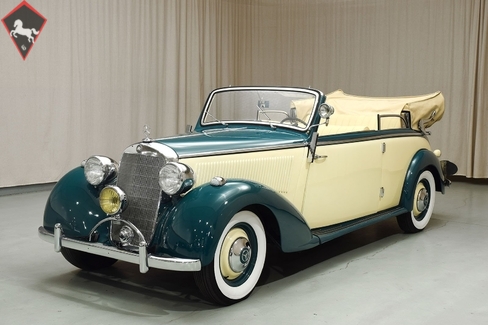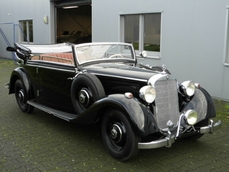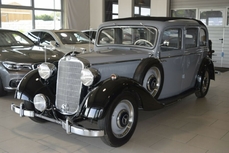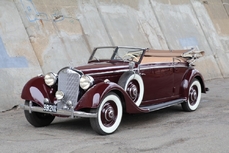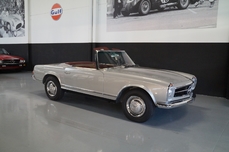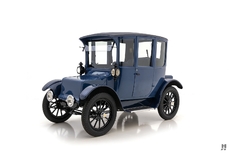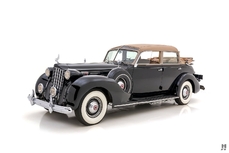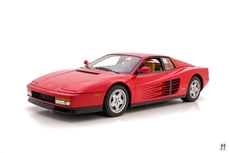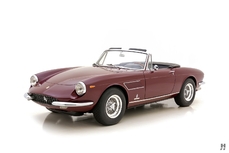Mercedes-Benz 230 W143 / W153 1940
General description :
For the casual enthusiast, Mercedes-Benz models of the immediate pre-war period can seem rather confusing, with many of the same model designations being utilized on different chassis and bodies. The Mercedes-Benz W153 was a mid-range luxury car that, typically for Mercedes at the time, was offered in a variety of factory body configurations, and one of several vehicles known simply as the “230”. It was sold in conjunction with the older W143 beginning in 1938, with production ceasing in 1941, though it was reborn after the war as the 170S. Body styles included a sedan, two-seat Cabriolet A, four-seat/two-door Cabriolet B and four-door/four-seat Cabriolet D.
When compared to the W143, the W153 had more full-bodied and modern styling complete with an integrated trunk. The chassis of the W153 was derived from the earlier car, an oval-tube affair with independent front and rear suspension and four-wheel hydraulic drum brakes. The six-cylinder engine displaced 2.3 liters (hence the “230” moniker) and breathed through a pair of Solex carburetors, making just 55 horsepower; thanks in part to the low 6.6:1 compression ratio. Power output was about the same as the W143, albeit with a bit more refinement and torque while power was fed to the rear wheels via a four-speed fully synchronized transmission. Performance is understandably relaxed, but the refinement and quality make the car feel much younger than its pre-war roots suggest. Germany’s government policies effected production as Mercedes was left little choice but to support the war effort, and as such, just 4,264 cars were produced through 1943.
This W153 230B Cabriolet B hails from 1940, and is a very attractive example of this rare and desirable pre-war Mercedes-Benz. Originally delivered to a Swiss customer, its history has been well documented through to present day. It has been treated to a comprehensive, photo-documented body-off restoration which was completed in 2009. It presents very handsomely with its aqua-green fenders and hood, with cream body sides and interior. The color-keyed green and cream wheels add a nice touch, and the exterior is very well detailed with period accessories such as a cowl lamp, semaphores, and a wonderful, large amber fog lamp mounted in the center of the grille on a unique arched bracket. The paint presents beautifully, with flawless reflections and good panel fit on the body. The chrome is likewise in beautiful order, with a gorgeous grille and fully chromed headlight pods forming the centerpiece of the front end. The lamps all wear correct fluted Bosch lenses, including the large and rare fog light. A Swiss identification plate is mounted to the chrome rear bumper, reminding us of this car’s origins.
In its day, the 230 was a car for the financially comfortable client. This fact is reflected in the luxurious interior, which features extensive wood trim and leather upholstery. The two-tone paint theme carries over into the cabin, with the green dash and cream-beige leather mirroring the colors of the bodywork. The upholstery is beautiful and shows very little in the way of use since the restoration was completed. Proper German square weave carpet lines the floor and the large rear seat features a fold down center arm rest. The signature of the Cabriolet B is the large folding top, which allows for plenty of room for four passengers whether in the up or down position. This example is properly upholstered in Sonnendeck canvas, and a large boot finishes off the looks when folded.
Motivation comes via the 2.3 liter inline six which looks good and runs strong. The engine bay is tidy and pleasingly detailed. This example features a floor-shift four-speed manual, and the full-synchromesh makes it a breeze to drive in all conditions. A particular highlight of our 230 Cab B is the full set of original fitted luggage found in the boot. Along with the fabulously well-preserved luggage, the requisite spare wheel shares space with a period jerry can and tool set. It is a wonderful collection of period accessories that only serve to enhance the charm of this handsome touring car.
With known history dating back to 1940, a full complement of wonderful period accessories and a very high quality restoration, this 230 Cabriolet B is a very desirable and rare Pre-War Mercedes Benz that would be very well suited to show or touring. It is our pleasure to offer it for sale.
http://hymanltd.com/vehicles/5704-1940-mercedes-benz-230-cabriolet-b/
1940 Mercedes-Benz 230 W143 / W153 is listed sold on ClassicDigest in St. Louis by Mark Hyman for $199500.
Car Facts
Car type : Car Make : Mercedes-Benz Model : 230 W143 / W153 Engine size : 0.0 Model Year : 1940 Sub type : Convertible Location : Missouri
Sold
Seller Information
Sold
People who viewed this Mercedes-Benz 230 W143 / W153 also viewed similar Mercedes-Benz listed at ClassicDigest
Other cars listed for sale by this dealer
About Mercedes-Benz
In the annals of automotive history, the journey of Mercedes-Benz is a tale that unfolds with the ingenuity of its founding pioneers. In the year 1886, Karl Benz crafted the Benz Patent Motorwagen, a creation that would go down in history as the world's inaugural automobile. Unbeknownst to him, this moment marked the genesis of what would evolve into the most illustrious premium car manufacturer globally. The financial underpinning of this pioneering venture, interestingly, was provided by Karl Benz's wife, Bertha Benz, demonstrating a remarkable partnership that would set the tone for Mercedes-Benz's legacy.A parallel narrative emerged not far away, as Daimler-Motoren-Gesellschaft, founded by Gottlieb Daimler and Wilhelm Maybach, entered the scene. In 1901, they unveiled their automobile under the now-famous moniker "Mercedes," meaning "godsend" in Spanish. This name was bestowed upon the car at the behest of Emil Jellinek's daughter, the distributor for Daimler-Motoren-Gesellschaft. The wheels of innovation were set in motion.
Fast forward to 1926, a pivotal year that witnessed the merger of Daimler with Benz & Cie., culminating in the birth of Daimler-Benz. The amalgamation saw the adoption of "Mercedes-Benz" as the distinguished trademark for their automobiles, fusing the legacies of two visionary entities into one.
Contrary to perceptions of conservatism, the trajectory of Daimler-Benz unfolds as a chronicle of industry firsts. From the introduction of the honeycomb radiator to the float carburetor, and the pioneering implementation of four-wheel brakes in 1924, Daimler-Benz consistently pushed the boundaries of automotive innovation. The diesel-powered Mercedes-Benz 260 D in 1936 marked the inception of diesel engines in passenger cars. The iconic Mercedes-Benz 300SL Gullwing made history as the first car with direct fuel injection, albeit the Gutbrod's tiny 2-stroke engine can claim precedence.
Safety innovations became a hallmark, with Béla Barényi's patented safety cell design in the "Ponton"-models in 1951, featuring front and rear crumple zones. The W116 450SEL 6.9 saw the introduction of the Anti-Lock Brake system (ABS), another pioneering safety feature. From the first production airbags and beyond, the legacy of "firsts" continued to be etched into the fabric of Daimler-Benz.
Over its centennial journey, Mercedes-Benz has not merely produced cars but has sculpted automotive icons. The SSKL, 710 SSK Trossi Roadster, 770K Grosser, 540K Spezial Roadster, 300SL Gullwing, w100 600 Pullman, w111 280SE 3.5 Flachkühler, w113 230SL Pagoda, w109 300 SEL 6.3, and w201 2.3-16 Cosworth stand testament to the brand's commitment to engineering excellence.
The roaring Silver Arrows, or "Silberpfeile," including the W 25, W 125, W154, W165, and W196, created a legacy of dominance on the racetrack. These machines were not merely cars; they were expressions of precision, speed, and an indomitable spirit that left their competitors in the dust.
As Mercedes-Benz marches into the future, it does so not just as an automaker but as a custodian of a legacy, a torchbearer of innovation, and a beacon of automotive excellence. The road ahead is sure to witness the continued fusion of cutting-edge technology, timeless design, and an unwavering commitment to setting new standards in the world of automobiles.
One luminary figure who left an indelible mark was Béla Barényi, often heralded as the "father of passive safety" for his pioneering work in safety engineering. His patented safety cell design, featuring front and rear crumple zones, became a hallmark of Mercedes-Benz's commitment to occupant safety, setting new standards that reverberated throughout the automotive world.
Moving through the chronicles, the collaborative genius of Wilhelm Maybach, alongside Gottlieb Daimler, laid the foundation for Daimler-Motoren-Gesellschaft. Their innovations not only birthed the first Mercedes but established a culture of relentless pursuit of technological excellence that remains integral to Mercedes-Benz's DNA.
In the post-merger era of 1926, Ferdinand Porsche emerged as a prominent figure within Mercedes-Benz. His work on the Mercedes-Benz S-Type, a supercharged race car, garnered acclaim and set the stage for a legacy that extended far beyond the marque. Porsche's impact would later extend to his eponymous company, but his influence at Mercedes-Benz during those formative years was pivotal.
As the 20th century progressed, the legendary Rudolf Uhlenhaut emerged as a key figure. Uhlenhaut, an accomplished engineer and the driving force behind the iconic Silver Arrows, played a crucial role in Mercedes-Benz's dominance in motorsports. His engineering prowess and attention to detail were instrumental in creating some of the most formidable racing cars of the era.
In the latter half of the century, figures like Bruno Sacco, the head of design at Mercedes-Benz from 1975 to 1999, left an indelible imprint on the brand's aesthetic identity. Sacco's design philosophy, characterized by clean lines and timeless elegance, shaped iconic models like the W126 S-Class and the W201 190E, solidifying Mercedes-Benz's reputation for luxury and sophistication.
The narrative would be incomplete without acknowledging the contributions of engineers like Hans Scherenberg, whose leadership in the 1970s ushered in a new era of technological innovation at Mercedes-Benz. Scherenberg's tenure saw the development of groundbreaking technologies, including the Anti-Lock Brake system (ABS) and the introduction of airbags in production cars.
